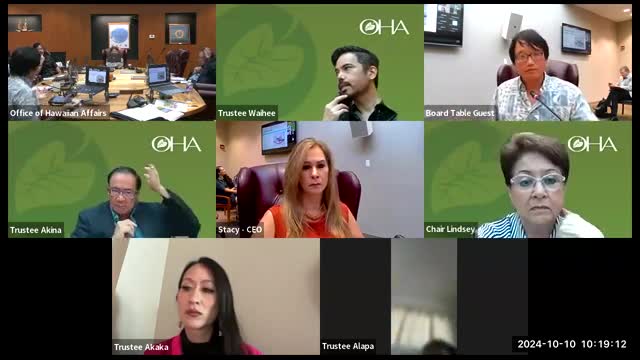Navy faces scrutiny over water contamination crisis
October 10, 2024 | Task Force Created by Act 170, Executive , Hawaii
This article was created by AI summarizing key points discussed. AI makes mistakes, so for full details and context, please refer to the video of the full meeting. Please report any errors so we can fix them. Report an error »

In a recent government meeting, officials addressed the ongoing crisis stemming from the November 2021 fuel leak at the Red Hill Bulk Fuel Storage Facility, which contaminated the drinking water supply for 93,000 residents. Approximately 19,000 gallons of fuel were released, with lingering concerns about an estimated 5,000 gallons of jet fuel and other hazardous substances remaining in the aquifer. Recent tests have detected polycyclic aromatic hydrocarbons in monitoring wells, indicating a potential plume moving towards municipal water sources.
In response, the Board of Water Supply and city council members are demanding weekly groundwater testing by the Navy, utilizing third-party experts to ensure unbiased results. Concerns were raised about the Navy's previous testing protocols, which were deemed invalid, leading to questions about the credibility of their findings. The need for an EPA-certified water lab in Hawaii was emphasized, as current samples are sent to the mainland, causing delays and potential backlogs.
Officials highlighted the necessity for a remediation authority to oversee cleanup efforts, with estimates suggesting that remediation could cost upwards of $750 million and take decades to complete. Legislative proposals are expected to establish this authority, which would also manage federal funds for remediation efforts. Additionally, there are calls for increased fines for water code violations, as current penalties are seen as insufficient to deter large entities like the Department of Defense.
The meeting also touched on the importance of public engagement in the remediation process, ensuring that community voices are heard and that the Navy is held accountable for its actions. The establishment of a water management area in West Maui was discussed, which would require permits for water use and prioritize public trust purposes, including traditional Hawaiian practices and food security.
Overall, the discussions underscored the urgent need for effective oversight and remediation strategies to address the contamination crisis, protect public health, and ensure sustainable water management for future generations.
In response, the Board of Water Supply and city council members are demanding weekly groundwater testing by the Navy, utilizing third-party experts to ensure unbiased results. Concerns were raised about the Navy's previous testing protocols, which were deemed invalid, leading to questions about the credibility of their findings. The need for an EPA-certified water lab in Hawaii was emphasized, as current samples are sent to the mainland, causing delays and potential backlogs.
Officials highlighted the necessity for a remediation authority to oversee cleanup efforts, with estimates suggesting that remediation could cost upwards of $750 million and take decades to complete. Legislative proposals are expected to establish this authority, which would also manage federal funds for remediation efforts. Additionally, there are calls for increased fines for water code violations, as current penalties are seen as insufficient to deter large entities like the Department of Defense.
The meeting also touched on the importance of public engagement in the remediation process, ensuring that community voices are heard and that the Navy is held accountable for its actions. The establishment of a water management area in West Maui was discussed, which would require permits for water use and prioritize public trust purposes, including traditional Hawaiian practices and food security.
Overall, the discussions underscored the urgent need for effective oversight and remediation strategies to address the contamination crisis, protect public health, and ensure sustainable water management for future generations.
View full meeting
This article is based on a recent meeting—watch the full video and explore the complete transcript for deeper insights into the discussion.
View full meeting
